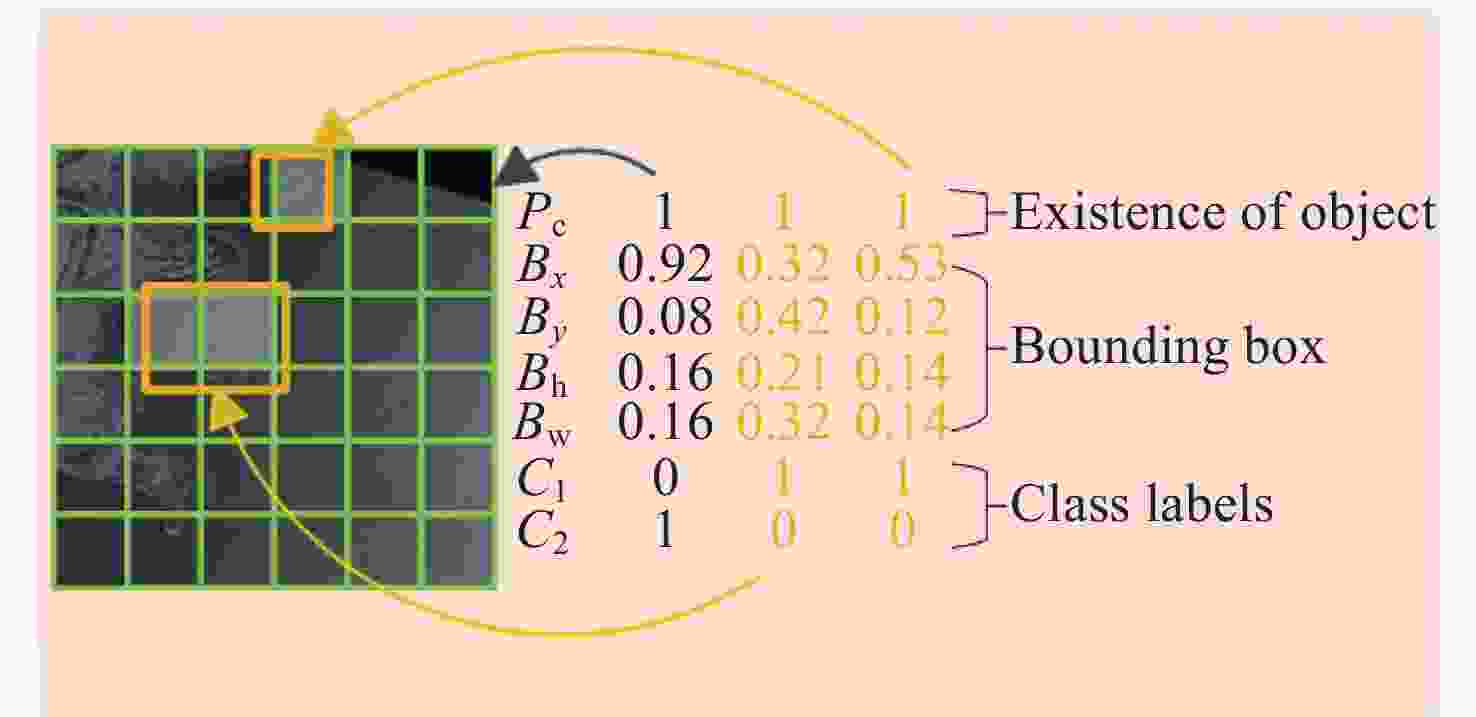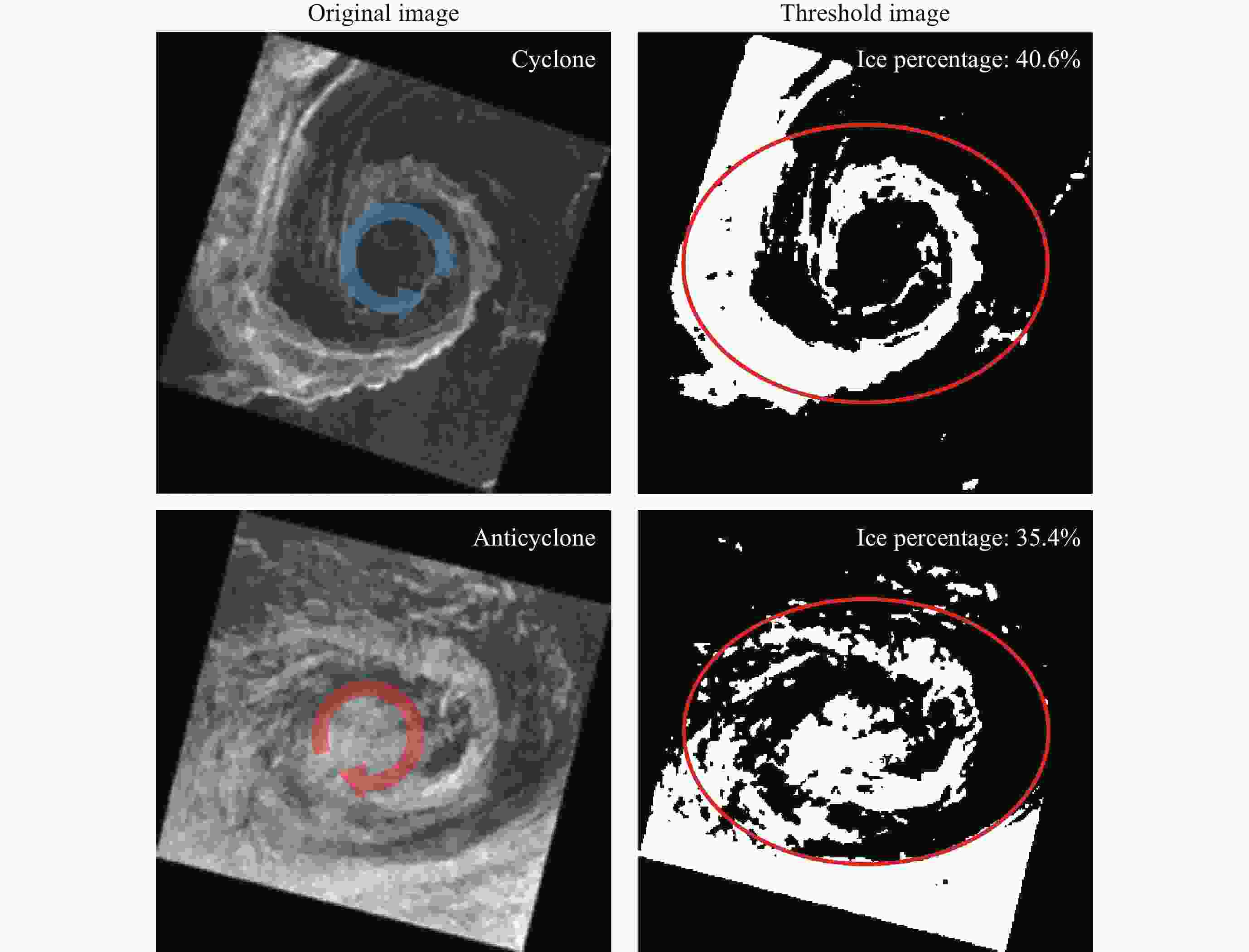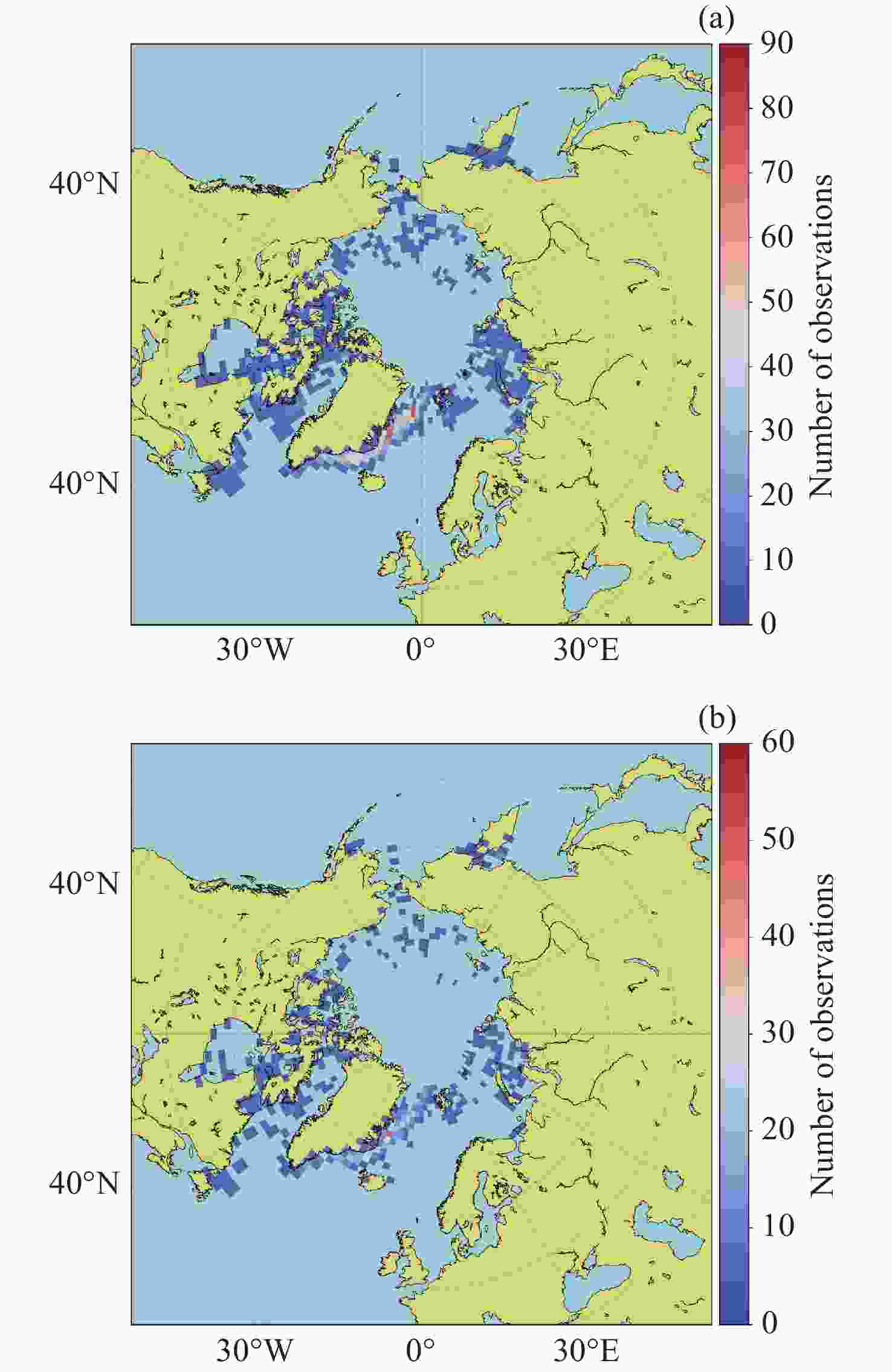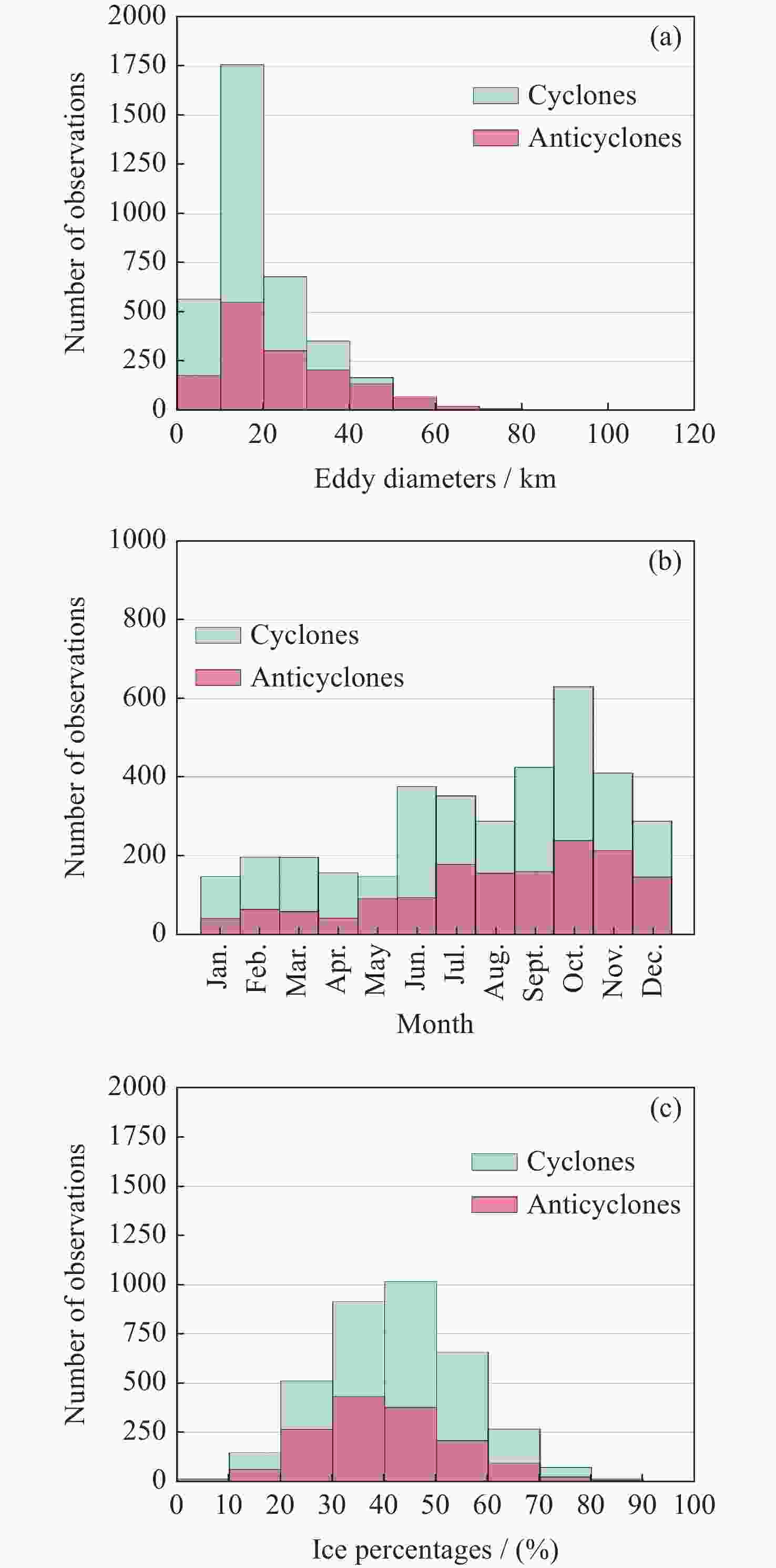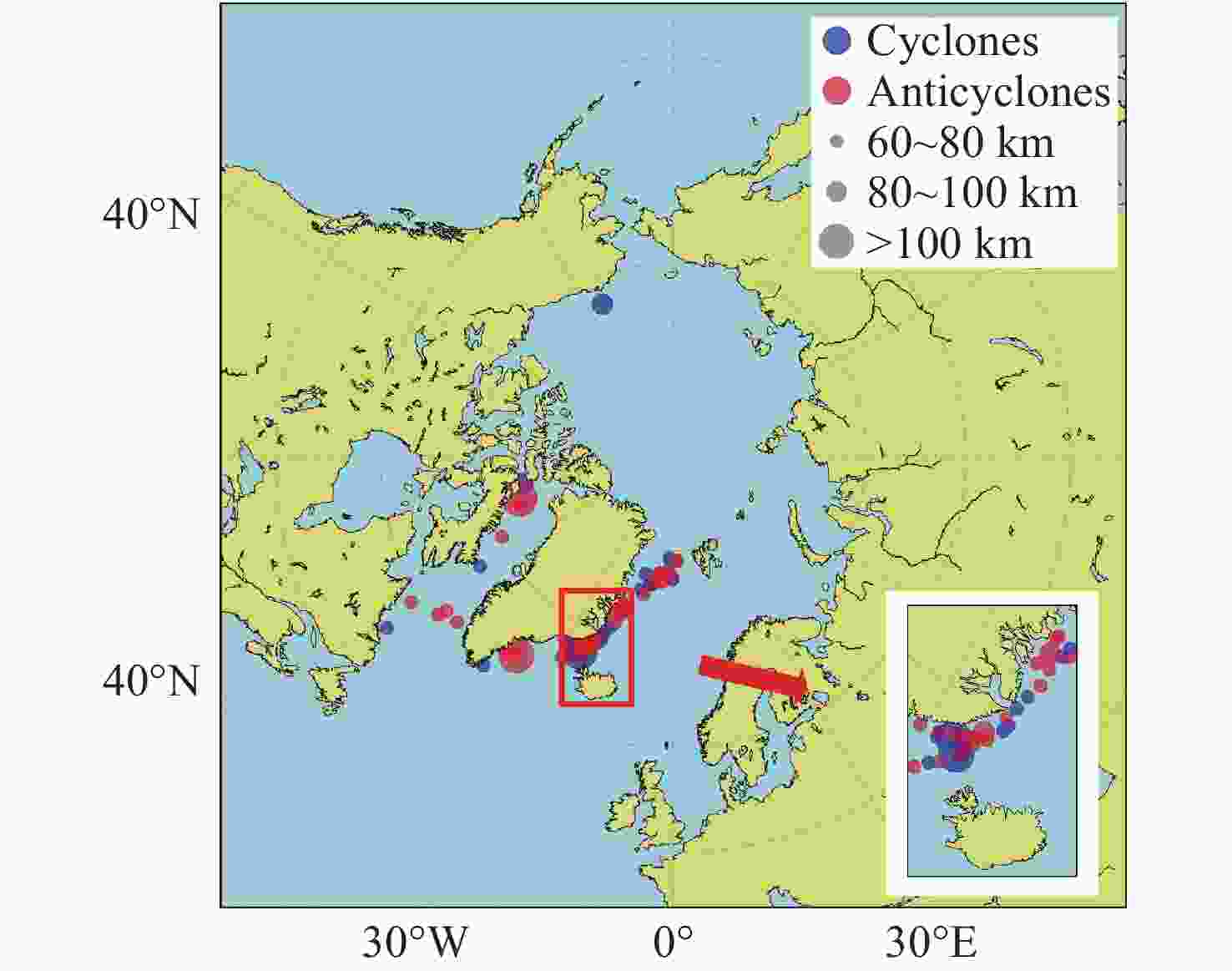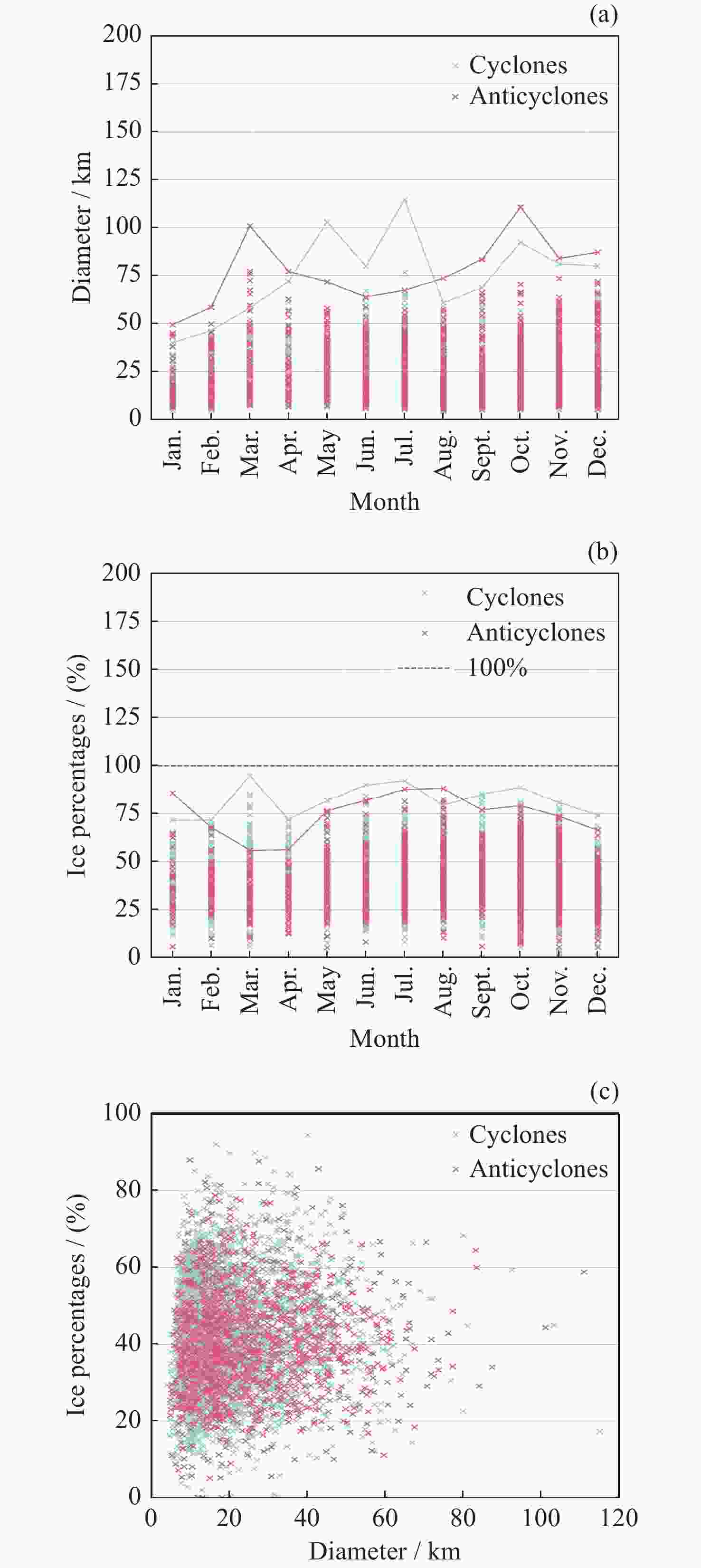Spatio-temporal Distribution Characteristics of Arctic Ice Eddies Based on SAR Satellite Observations
-
摘要: 北冰洋复杂的寒、暖洋流交汇作用为涡旋的生成和发展提供了适宜的条件。在北极边缘冰区,上层浮冰示踪海洋涡旋,形成冰涡特征。冰涡通过垂直热量传输加速上层浮冰的消融,影响着边缘冰区的演变,间接调节全球气候。本文利用高空间分辨率的合成孔径雷达(SAR)卫星影像开展了北极冰涡检测识别与时空特征分析研究。基于SAR影像构建训练数据集,采用YOLOv7目标检测模型完成模型训练任务;对2022年北极冰涡影像进行检测识别,在此基础之上进行目视解译处理。基于目视解译结果开展冰涡特征分析。目视解译共确定3615个气旋型冰涡和1482个反气旋型冰涡,这些冰涡主要在7-11月生成,集中分布于格陵兰岛东部沿岸和格陵兰海中北部,冰涡的平均直径为21.2 km,平均海冰占比为41.76%。本文的冰涡检测识别和时空特征分析研究结果为北极地区海洋现象分析与气候研究提供了有价值的方法参考和遥感分析资料。
-
关键词:
- 合成孔径雷达(SAR) /
- 冰涡 /
- YOLO /
- 检测识别 /
- 特征分析
Abstract: The complex interaction between cold and warm ocean currents in the Arctic Ocean creates favorable conditions for the formation and growth of eddies. In the marginal ice zone of the Arctic, some of the upper ice floes, resulting in the formation of distinctive rotational features. These features, which contain traces of ice floes, are referred to as “ice eddies” in this paper. Ice eddies accelerate the melting of the upper ice floes through vertical heat transfer, which affects the development of the marginal ice zone and indirectly regulates the global climate. In this paper, a study is conducted on the detection, identification, and spatial and temporal characterization of Arctic ice eddies using high-resolution Synthetic Aperture Radar (SAR) satellite images of 2022. Firstly, a training dataset is constructed using preprocessed SAR images, and the YOLOv7 target detection model is used to train the model. Then, the process of human-supervised visual identification is conducted based on the results of detection and identification, resulting in the identification of a total of 3615 cyclonic ice eddies and 1482 anticyclonic ice eddies. Finally, the ice eddies are characterized using the visual identification results mentioned above. The statistical results show that ice eddies in the Arctic Ocean are primarily generated from July to November. Their spatial distribution is concentrated along the eastern coast of Greenland and in the north-central Greenland Sea. The diameters of the ice eddies range from 3.85 to 114.9 km. 99% of the eddies are smaller than 60 km, with an average diameter of 21.2 km. 97% of the eddies have sea-ice coverage ranging from 20% to 70%, with an average sea-ice coverage of 41.76%. The results of the ice eddies detection, identification, and spatial and temporal characterization in this paper provide valuable methodological references and remote sensing analysis information for analyzing marine phenomena and conducting climate research in the Arctic region. -
表 1 哨兵一号卫星成像模式及参数
Table 1. Sentinel-1 imaging modalities and parameters
成像模式 分辨率
/m幅宽
/km极化方式 SM 5×5 80 VV+VH/HH+HV/HH/VV IW 5×20 250 VV+VH/HH+HV/HH/VV EW 20×40 400 VV+VH/HH+HV/HH/VV WV 5×5 20×20 HH/VV 表 2 北极冰涡检测SAR数据统计(哨兵一号卫星)
Table 2. SAR data statistics for Arctic ice eddy detection (Sentinel-1)
Year Jan. Feb. Mar. Apr. May Jun. Jul. Aug. Sept. Oct. Nov. Dec. Total 2014 - - - - - - - - - 291 23 9 323 2022 84 63 95 68 67 181 268 238 151 196 161 129 1701 -
[1] D'ASARO E A. Observations of small eddies in the Beaufort Sea[J]. Journal of Geophysical Research: Oceans, 1988, 93(C6): 6669-6684 doi: 10.1029/JC093iC06p06669 [2] JOHANNESSEN J A, RØED L P, WAHL T. Eddies detected in ERS-1 SAR images and simulated in reduced gravity model[J]. International Journal of Remote Sensing, 1993, 14(11): 2203-2213 doi: 10.1080/01431169308954029 [3] MANLEY T O, HUNKINS K. Mesoscale eddies of the arctic ocean[J]. Journal of Geophysical Research: Oceans, 1985, 90(C3): 4911-4930 doi: 10.1029/JC090iC03p04911 [4] SPALL M A, PICKART R S, FRATANTONI P S, et al. Western Arctic shelfbreak eddies: Formation and transport[J]. Journal of Physical Oceanography, 2008, 38(8): 1644-1668 doi: 10.1175/2007JPO3829.1 [5] GILL A E, GREEN J S A, SIMMONS A J. Energy partition in the large-scale ocean circulation and the production of mid-ocean eddies[J]. Deep Sea Research and Oceanographic Abstracts, 1974, 21(7): 509-528 [6] PEDLOSKY J. On the radiation of meso-scale energy in the mid-ocean[J]. Deep Sea Research, 1977, 24(6): 591-600 doi: 10.1016/0146-6291(77)90529-X [7] MENEGHELLO G, MARSHALL J, LIQUE C, et al. Genesis and decay of mesoscale baroclinic eddies in the seasonally ice-covered interior arctic ocean[J]. Journal of Physical Oceanography, 2021, 51(1): 115-129 doi: 10.1175/JPO-D-20-0054.1 [8] CASSIANIDES A, LIQUE C, KOROSOV A. Ocean eddy signature on SAR‐derived sea ice drift and vorticity[J]. Geophysical Research Letters, 2021, 48(6): e2020GL092066 doi: 10.1029/2020GL092066 [9] 李威, 王琦, 马继瑞, 等. 台湾以东黑潮锋的中尺度过程研究[J]. 海洋通报, 2011, 30(5): 518-528 doi: 10.3969/j.issn.1001-6392.2011.05.007LI Wei, WANG Qi, MA Jirui, et al. Study on the meso-scale process of the Kuroshio front to the east of Taiwan[J]. Marine Science Bulletin, 2011, 30(5): 518-528 doi: 10.3969/j.issn.1001-6392.2011.05.007 [10] FRENGER I, GRUBER N, KNUTTI R, et al. Imprint of Southern Ocean eddies on winds, clouds and rainfall[J]. Nature Geoscience, 2013, 6(8): 608-612 doi: 10.1038/ngeo1863 [11] ROBINSON A R. Overview and summary of eddy science[M]//ROBINSON A R. Eddies in Marine Science. Berlin: Springer, 1983: 3-15 [12] CHEN G X, GAN J P, XIE Q, et al. Eddy heat and salt transports in the South China Sea and their seasonal modulations[J]. Journal of Geophysical Research: Oceans, 2012, 117(C5): C05021 [13] WANG X D, LI W, QI Y Q, et al. Heat, salt and volume transports by eddies in the vicinity of the Luzon Strait[J]. Deep Sea Research Part I: Oceanographic Research Papers, 2012, 61: 21-33 doi: 10.1016/j.dsr.2011.11.006 [14] CHELTON D B, SCHLAX M G, SAMELSON R M, et al. Global observations of large oceanic eddies[J]. Geophysical Research Letters, 2007, 34(15): L15606 [15] CARPENTER J R, TIMMERMANS M L. Deep mesoscale eddies in the Canada Basin, Arctic Ocean[J]. Geophysical Research Letters, 2012, 39(20): L20602 [16] ZHAO M N, TIMMERMANS M L, COLE S, et al. Characterizing the eddy field in the Arctic Ocean halocline[J]. Journal of Geophysical Research: Oceans, 2014, 119(12): 8800-8817 doi: 10.1002/2014JC010488 [17] ZHAO M N, TIMMERMANS M L, COLE S, et al. Evolution of the eddy field in the Arctic Ocean's Canada Basin, 2005–2015[J]. Geophysical Research Letters, 2016, 43(15): 8106-8114 doi: 10.1002/2016GL069671 [18] VON APPEN W J, WEKERLE C, HEHEMANN L, et al. Observations of a submesoscale cyclonic filament in the marginal ice zone[J]. Geophysical Research Letters, 2018, 45(12): 6141-6149 doi: 10.1029/2018GL077897 [19] TOOLE J M, KRISHFIELD R A, TIMMERMANS M L, et al. The ice-tethered profiler: Argo of the Arctic[J]. Oceanography, 2011, 24(3): 126-135 doi: 10.5670/oceanog.2011.64 [20] KOZLOV I E, ARTAMONOVA A V, MANUCHARYAN G E, et al. Eddies in the Western Arctic Ocean from spaceborne SAR observations over open ocean and marginal ice zones[J]. Journal of Geophysical Research: Oceans, 2019, 124(9): 6601-6616 doi: 10.1029/2019JC015113 [21] CHELTON D B, SCHLAX M G, SAMELSON R M. Global observations of nonlinear mesoscale eddies[J]. Progress in Oceanography, 2011, 91(2): 167-216 doi: 10.1016/j.pocean.2011.01.002 [22] JOHANNESSEN J A, SHUCHMAN R A, DIGRANES G, et al. Coastal ocean fronts and eddies imaged with ERS 1 synthetic aperture radar[J]. Journal of Geophysical Research: Oceans, 1996, 101(C3): 6651-6667 doi: 10.1029/95JC02962 [23] JOHANNESSEN J A, KUDRYAVTSEV V, AKIMOV D, et al. On radar imaging of current features: 2. Mesoscale eddy and current front detection[J]. Journal of Geophysical Research: Oceans, 2005, 110(C7): C07017 [24] KOZLOV I E, ATADZHANOVA O A. Eddies in the marginal ice zone of fram strait and svalbard from spaceborne SAR observations in winter[J]. Remote Sensing, 2022, 14(1): 134 [25] LI X F, LIU B, ZHENG G, et al. Deep-learning-based information mining from ocean remote-sensing imagery[J]. National Science Review, 2020, 7(10): 1584-1605 doi: 10.1093/nsr/nwaa047 [26] BHAVYA SREE B, YASHWANTH BHARADWAJ V, NEELIMA N. An inter-comparative survey on state-of-the-art detectors—R-CNN, YOLO, and SSD[M]//REDDY A N R, MARLA D, FAVORSKAYA M N, et al. Intelligent Manufacturing and Energy Sustainability: Proceedings of ICIMES. Singapore: Springer, 2021 [27] TERVEN J, CORDOVA-ESPARZA D M. A comprehensive review of YOLO: From YOLOv1 to YOLOv8 and beyond[OL]. arXiv preprint arXiv: 230400501, 2023 [28] WANG X N, WANG X G, LI C, et al. Data-attention-YOLO (DAY): A comprehensive framework for mesoscale eddy identification[J]. Pattern Recognition, 2022, 131: 108870 doi: 10.1016/j.patcog.2022.108870 [29] CAO L J, ZHANG D J, GUO Q, et al. Ocean Mesoscale Eddies Identification Based on Yolof[C]//IGARSS 2022-2022 IEEE International Geoscience and Remote Sensing Symposium. Kuala Lumpur, Malaysia: IEEE, 2022 [30] KHACHATRIAN E, SANDALYUK N, LOZOU P. Eddy detection in the marginal ice zone with sentinel-1 data using YOLOv5[J]. Remote Sensing, 2023, 15(9): 2244 doi: 10.3390/rs15092244 [31] REDMON J, DIVVALA S, GIRSHICK R, et al. You only look once: Unified, real-time object detection[C]//2016 IEEE Conference on Computer Vision and Pattern Recognition. Las Vegas, NV, USA: IEEE, 2016 [32] WANG C Y, BOCHKOVSKIY A, LIAO H Y M. YOLOv7: Trainable bag-of-freebies sets new state-of-the-art for real-time object detectors[C]//Proceedings of 2023 IEEE/CVF Conference on Computer Vision and Pattern Recognition. Vancouver, BC, Canada: IEEE, 2023 [33] BONDEVIK E. Studies of eddies in the marginal ice zone along the east Greenland current using spaceborne synthetic aperture radar (SAR)[D]. Bergen: The University of Bergen, 2011 [34] PEROVICH D K, JONES K F. The seasonal evolution of sea ice floe size distribution[J]. Journal of Geophysical Research: Oceans, 2014, 119(12): 8767-8777 doi: 10.1002/2014JC010136 [35] MCWILLIAMS J C. Submesoscale currents in the ocean[J]. Proceedings of the Royal Society A: Mathematical, Physical and Engineering Sciences, 2016, 472 (2189): 20160117 [36] STRONG C, RIGOR I G. Arctic marginal ice zone trending wider in summer and narrower in winter[J]. Geophysical Research Letters, 2013, 40(18): 4864-4868 doi: 10.1002/grl.50928 [37] MANUCHARYAN G E, THOMPSON A F. Submesoscale sea ice-ocean interactions in marginal ice zones[J]. Journal of Geophysical Research:Oceans, 2017, 122(12): 9455-9475 doi: 10.1002/2017JC012895 -
-





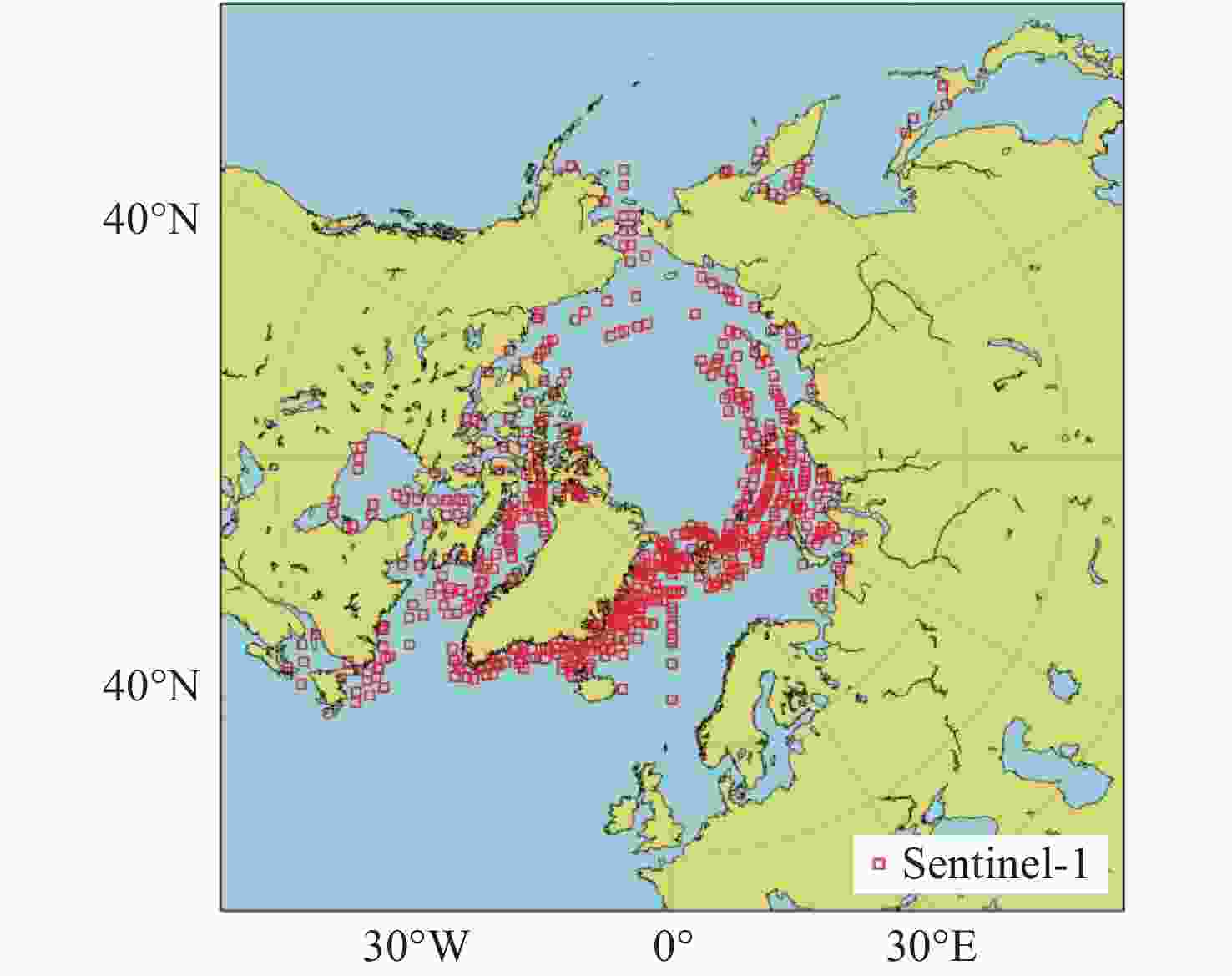
 下载:
下载:
